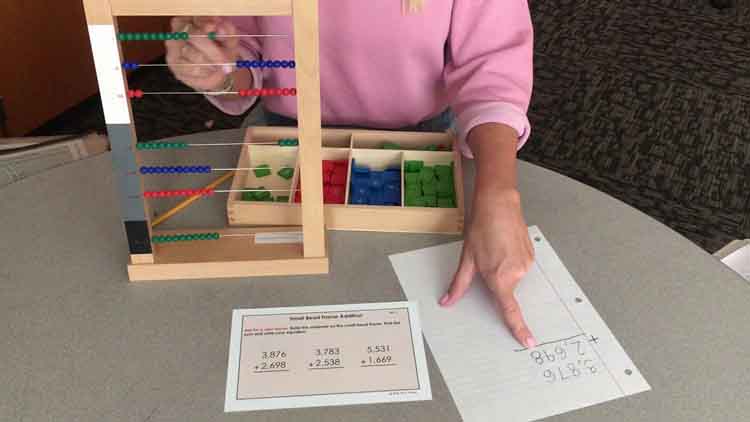Fine motor skills are crucial for a child’s overall development. These skills involve the coordination of small muscles in the hands and fingers, which are essential for tasks like writing, buttoning clothes, and tying shoelaces. One excellent way to support the development of fine motor skills is through the Montessori Hook and Eye Frame activity. This practical life exercise is simple yet effective in promoting dexterity, concentration, and independence in young learners.
What is the Hook and Eye Frame?
The Hook and Eye Frame is a Montessori tool designed to help children learn how to manipulate small fasteners commonly found on clothing, such as hooks and eyes. The frame typically consists of fabric stretched over a wooden frame, with several hook-and-eye pairs attached. This design allows children to practice fastening and unfastening at their own pace, fostering both skill and confidence.
Why Focus on Fine Motor Skills?
Fine motor skills play a critical role in a child’s ability to perform everyday tasks. Strengthening these skills supports a range of developmental milestones:
- Improved Handwriting: Strong fine motor control helps children hold and manipulate pencils or crayons effectively.
- Enhanced Self-Care: Tasks like dressing, eating, and grooming require precise finger movements.
- Problem-Solving Abilities: Engaging in hands-on activities like the Hook and Eye Frame encourages children to think critically and find solutions.
- Increased Independence: When children master fine motor tasks, they gain confidence and a sense of autonomy.
Benefits of the Hook and Eye Frame Activity
The Hook and Eye Frame activity is more than just a practice in fastening; it offers a range of developmental advantages:
1. Strengthens Finger Muscles
The repeated motion of hooking and unhooking develops strength and dexterity in the fingers, preparing them for more complex tasks.
2. Builds Hand-Eye Coordination
Aligning the hook with the eye requires precise coordination between the eyes and hands, improving spatial awareness and control.
3. Promotes Concentration
The activity demands focus and attention, which helps children develop the ability to concentrate for extended periods.
4. Encourages Independence
Mastering the use of hooks and eyes fosters self-reliance, as children can apply their skills to real-life tasks like dressing.
5. Develops Patience and Persistence
The activity may be challenging at first, but with practice, children learn the value of perseverance and problem-solving.
How to Introduce the Hook and Eye Frame
Integrating the Hook and Eye Frame into a child’s routine is easy and rewarding. Here’s a step-by-step guide:
Materials Needed
- A Montessori Hook and Eye Frame.
- A comfortable workspace at the child’s height.
Step-by-Step Instructions
- Invite the Child
Gently invite the child to join the activity, using language that sparks curiosity, such as, “Would you like to learn how to fasten hooks and eyes?” - Demonstrate the Process
Sit beside the child and demonstrate how to fasten and unfasten one hook and eye. Perform the action slowly and deliberately, explaining each step. - Encourage Practice
Hand the frame to the child and encourage them to try. Offer minimal assistance, allowing them to explore and learn through trial and error. - Provide Positive Reinforcement
Praise their efforts, regardless of the outcome, to build confidence and motivation. - Repeat and Reinforce
Allow the child to practice regularly. Repetition is key to mastering the skill.
Tips for Success
- Use Child-Friendly Frames: Ensure the frame is designed for small hands and is easy to manipulate.
- Start Simple: If the child finds the hooks and eyes challenging, introduce simpler fasteners first, such as buttons or zippers.
- Be Patient: Learning new skills takes time. Offer encouragement and patience as the child progresses.
- Create a Calm Environment: Minimize distractions to help the child focus on the task.
Extending the Activity
Once the child is comfortable with the Hook and Eye Frame, consider these extensions to enhance their learning:
- Practical Application: Provide clothing or accessories with hooks and eyes for real-life practice.
- Sensory Exploration: Introduce other types of fasteners, such as snaps, Velcro, or laces, to expand their dexterity.
- DIY Frames: Involve the child in creating their own fastening frame using fabric, cardboard, and craft supplies.
Why Montessori Emphasizes Practical Life Activities
Montessori education prioritizes practical life activities like the Hook and Eye Frame because they are foundational to a child’s development. These activities not only teach essential life skills but also nurture independence, self-discipline, and a love for learning.
The Hook and Eye Frame, in particular, aligns perfectly with the Montessori philosophy of fostering growth through hands-on, purposeful work. By engaging in this activity, children learn far more than just how to fasten hooks and eyes—they gain confidence, patience, and the ability to tackle challenges head-on.
The Hook and Eye Frame activity is a valuable tool in helping children develop fine motor skills. Through this hands-on exercise, children strengthen their hand muscles, enhance coordination, and build independence—all while having fun and learning a practical life skill.
Whether you’re a parent incorporating Montessori methods at home or an educator seeking engaging classroom activities, the Hook and Eye Frame is an excellent choice. It offers children the opportunity to grow not only in dexterity but also in confidence and independence, laying the foundation for future success.
Invest in a Hook and Eye Frame today and watch your child thrive as they master this essential skill, one hook and eye at a time!
Content Prepared by: Pratheek
Contact: +91 98468 08283




